Scolecopteris, the
maggot fern: "maggots" fat and lean
The pinnules of the large fronds of the big tree ferns whose fossil
trunks are known as Psaronius
* had not been recognized as plant fossils
when first discovered in rare chert samples, called maggot stones,
found in the
Lower Permian Döhlen basin near Dresden, Upper
Saxony, in the second half of 18th century. The small curved pinnules
with sporangia and fringes pointing downward were mistaken for little
arthropods as they are seldom seen nearly as distinctly as in
Fig.1. After they had been recognized as plant parts, they got the name
Scolecopteris,
which literally means maggot fern, with the species name
elegans, in
1837 [1]. The amusing and instructive story of repeated
misinterpretations of
the "maggot stones"
has been told elsewhere [2]. It may
serve as an encouragment to question recent interpretations.

Fig.1: Scolecopteris
pinnules as seen on the surface of a chert fragment
smoothed by water transport : The
sporangia (partially fused into synangia) seen on the lengthwise
section (left) and the fringes seen on
the pinnule in side view (right) are liable to be mistaken for
arthropod limbs if less well preserved. Width of the drawing 8mm.
The recent recovery of more than a thousand fossiliferous chert samples
from the type locality of Scolecopteris
elegans,
starting with the purposeful search by Gert Müller and H.Ahlheim
in 1985,
has revealed a large variety of pinnules, including such ones that look
like grubs or nymphs of some insect (Fig.2) still
more than
those ones did which
fooled the 18th century scholars. As one of several indications of
diversity, the curvature of the pinnules is distinct in Fig.1 but
insignificant in
Fig.2.
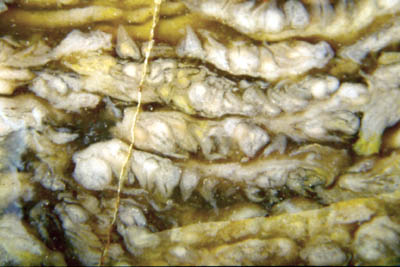
Fig.2: "Maggot stone" of uncommon aspect: Scolecopteris
pinnules with rather lean constitution
and unevenly developed sporangia.
Width of
the picture 7mm.
It is not obvious which ones of such examples of
variety are due to the variability of the species or to the
presence of other species, possibly undescribed ones. Nevertheless, all
recent finds in the Döhlen basin have
been assigned
to the same species [2,4]. Evidence has accumulated which casts
severe
doubts upon the hypothesis of only one species. Hence, the
recent finds have to be
compared with
more than two dozen Scolecopteris
species hitherto discovered worldwide [5].
As
an intriguing fact, fertile and sterile pinnules shaped such that they
may be called succulent (Figs.3-6) have been found among those of
normal aspect (Fig.7) even in one and the same chert sample, which
means they became silicified within the same layer of mud.
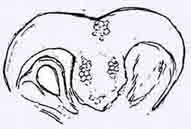

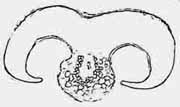
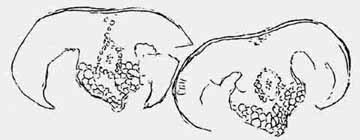
Figs.3-6: Cross-sections of thick pinnules of Scolecopteris found in
small numbers among the leaner ones in the sample of Fig.7.
Fig.3: 2.3mm wide, with sporangia, others sterile, same scale.
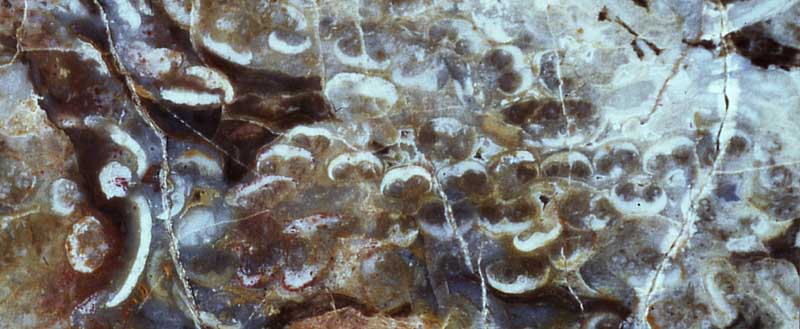
Fig.7: Cut
face of a
chert sample of uncommon aspect containing thousands of fertile
and sterile
Scolecopteris pinnules.
Note the lengthwise section of a pinnule related to a pinna
cross-section on the left, also the tiny black dot on one of the
fertile pinnule cross-sections
indicating the
central strand of the pinnule midrib (on the right). Width of the
picture
32mm.
The pinnules with bloated midrib (Figs.3-6) were first noticed in one
sample of a rare chert variety (Fig.7), where they make
up about 1% of the total amount of pinnules. They had been pictured in
[4] but their presence among the leaner pinnules has not been
adequately discussed or explained hitherto. Hence, the observation
deserves
further attention.
The sample is an old fragment of a solid and rather homogeneous chert
layer, and the fat pinnules are not restricted to a particular position
in the layer. This seems to indicate that they grew among the normal
foliage. As they are seen in rows of two or three
(Fig.6), the abnormal growth is not confined to individual
pinnules but affects the pinna or frond part.
Fungus infection is known as a cause of abnormal growth, including
hypertrophy of tissue, which can be useful for water storage. Symbiotic
fungi seem to have been present even in the first land plants [6].
Hence, fungus activity should always be considered if
unexpected phenomena in plants defy other explanations.
Samples: Old fragments of Lower Permian chert with more or
less rounded
edges, found among younger fluviatile
deposits in Döhlen basin near Dresden, Saxony, Germany.
Fig.1: Pe/3, found in 1994 near Pesterwitz, apparently as the only
sample
with pinnules ever found there.
Fig.2: Bu8/23.2 , found in 1997 by U. Wagner on
the area of Burgk close
to the historic "maggot stone" site near Kleinnaundorf. For a wider
view of this sample see [7], Bild 67. (The mirror
image is
reproduced there, and not in natural size as claimed there but
magnified by a factor of 1.7 .) The sample is kept by U. Wagner, Dresden.
Figs.3-7: H2/1+35, found in 1993 at Hänichen.
Fig.7: H2/35.1, Photograph by M. Barthel (1994),
detail.
The samples Pe/3 and H2/1+35 are of a rare
black/gray/white variety, own finds, stored in
the own collection. H2/1 and H2/35 had been
found separately, with months in between, and later
recognized as fitting together.
* A most remarkable collection of big polished Psaronius sections
is on display at the Naturkunde Museum Chemnitz [7].
H.-J.
Weiss
2011
[1] F.C. Zenker
: Scolecopteris elegans, ein neues fossiles
Farrngewächs mit Fructification. Linnaea 11(1837), 509-12
[2] M. Barthel
: The maggot stones from Windberg
ridge. in: U. Dernbach, W.D. Tidwell :
Secrets of Petrified Plants, D'ORO Publ., 2002. p65-77.
[3] G.
Müller : www.gerts-madensteinseite-by.der-starhopper.de
[4] M.
Barthel, W. Reichel, H.-J. Weiss : "Madensteine" in
Sachsen. Abhandl. Staatl. Mus. Mineral.
Geol. Dresden 41(1995), 117-135.
[5] M.A. Millay
: A review of permineralized Euramerican Carboniferous
tree ferns. Rev. Palaeobot. Palyn.
95(1997), 191-209.
[6] T.N.
Taylor, E.L. Taylor, M. Krings : Paleobotany,
Elsevier 2009.
[7] R. RÖßLER: Der
versteinerte Wald von Chemnitz, Museum für Naturkunde Chemnitz 2001.
|
 |
 1 1 |

 1
1







 1
1